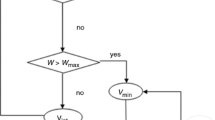Abstract
In this article, the methodology to implementation of high resolution thermogravimetric analysis (HRTG) for construction materials like Portland cement pastes is presented. The aim of this technique is to make easier the identification of the decomposition reactions that frequently are overlapping on conventional thermogravimetric analysis (TG) like is the case of some mineral phases in the cement pastes. The optimum parameters related to sample mass and purge flow gas were established. It is necessary carried out the analysis with high quantity of sample (60 mg in this case) and without purge gas in order to get better results and excellent reproducibility. The tests have average heating rate higher than 3 °C min−1 in the temperature range studied (35–300 °C), showing that the HRTG is not time-expensive technique.










Similar content being viewed by others
References
Borrachero MV, Payá J, Bonilla M, Monzó J. The use of thermogravimetric analysis technique for the characterization of construction materials: the gypsum case. J Therm Anal Calorim. 2008;91–92:503–9.
Ramachandran VS, Paroli RM, Beaudoin JJ, Delgado AH. Thermal analysis of construction materials. Building materials series. New York: Noyes Publications; 2003.
Ramachandran VS. Application of differential thermal analysis in cement chemistry. New York: Chemical Publishing Co., Inc.; 1969.
Vechio S, La Ginestra A, Frezza A, Ferragine C. The use thermoanalytical techniques in the characterization of ancient mortars. Thermochim Acta. 1993;227:215–23.
Anastiasiou M, Hasapis Yh, Zorba T, Pavlidou E, Chfissafis K, Parasakevopoulos KM. TGA-DTA and FTIR analyses of plasters form byzantine monuments in Balkan region. J Therm Anal Calorim. 2006;84:27–32.
Brown ME. Introduction to thermal analysis technique and applications. London: Chapman and Hall; 1998.
Riesen R. Adjustment of heating rate for maximum resolution in TG and TMA (MaxRes). J Therm Anal Calorim. 1998;53:365–74.
Haines PJ. Thermal methods of analysis. London: Blackie Academic Professional; 1995.
Dweck J, Büchler PM, Celho ACV, Cartledge FK. Hydration of cement bended with calcium carbonate. Thermochim Acta. 2000;346:105–13.
Pacewska JB, Wilinska I, Bukowska M, Blonkowski G, Nocun-Wczelik WJ. An attempt to improve the pozzolanic activity of waste aluminosilicate catalyst. J Therm Anal Calorim. 2004;77:133–42.
Payá J, Monzó J, Borrachero MV, Velazquez S. Evaluation of the pozzolanic activity of fluid catalytic cracking catalyst residue (FC3R) thermogravimetric analysis studies of FC3R-Portland cement pastes. Cem Concr Res. 2003;33:603–9.
Pinto CA, Büchler PM, Dweck JJ. Pozzolanic properties of a residual FCC catalyst during the early stages of cement hydration. J Therm Anal Calorim. 2007;87:715–20.
Rojas MF, Cabrera J. The effect of temperature on the hydration rate and stability of the hydration phases of metakaolin-lime water systems. Cem Concr Res. 2002;32:133–8.
Dweck J, Ferreira Da Silva PF, Silva Aderne R, Büchler PM, Cartledge Fk. Evaluating cement hydration by non-conventional DTA: an application to waste solidification. J Therm Anal Calorim. 2003;71:821–7.
Criado JM, Pérez-Maqueda LA, Diánez MJ, Sánchez-Jiménez PE. Development of a universal constant rate thermal analysis system for being used with any thermoanalytical instrument. J Therm Anal Calorim. 2007;87:297–300.
Gill PS, Sauerbrunn SR, Crowe BS. High resolution thermogravimetry. J Therm Anal Calorim. 1992;38:255–66.
Frost RL, Martens W, Ding Z, Kloprogge JT. DSC and high-resolution TG of synthesized hydrotalcites of Mg and Zn. J Therm Anal Calorim. 2003;71:429–38.
Ozawa T. Controlled rate thermogravimetry new usefulness of controlled rate thermogravimetry revealed by decomposition of polyimide. J Therm Anal Calorim. 2000;59:375–84.
Zanier A. High resolution TG for characterization of diesel fuel additives. J Therm Anal Calorim. 2001;64:377–84.
Mojundar SC, Sain M, Prasad RC, Sun L, Venart ES. Selected thermoanalytical methods and their applications from medicine to construction. Part I. J Therm Anal Calorim. 2007;90:653–62.
Acknowledgements
The authors expressed their thanks to ARGOS Cement Company and to COLCIENCIAS (project 20201007768) of Colombia for their economic support for the realization of this research. Also, we would like thank to MICINN (Spanish Ministry of Science and Innovation) and FEDER for the support of the project BIA 2007-63252.
Author information
Authors and Affiliations
Corresponding author
Rights and permissions
About this article
Cite this article
Tobón, J.I., Paya, J., Borrachero, M.V. et al. Determination of the optimum parameters in the high resolution thermogravimetric analysis (HRTG) for cementitious materials. J Therm Anal Calorim 107, 233–239 (2012). https://doi.org/10.1007/s10973-010-0997-0
Received:
Accepted:
Published:
Issue Date:
DOI: https://doi.org/10.1007/s10973-010-0997-0




